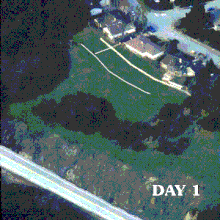
Back انهيار أرضي Arabic ভূমিস্খলন Assamese Argayu AST Torpaq sürüşməsi Azerbaijani Pagrasay kan daga BCL Апоўзень Byelorussian Апоўзень BE-X-OLD Свлачище Bulgarian Rumbih BJN ভূমিধস Bengali/Bangla




Landslides, also known as landslips, or rockslides,[3][4][5] are several forms of mass wasting that may include a wide range of ground movements, such as rockfalls, mudflows, shallow or deep-seated slope failures and debris flows.[6] Landslides occur in a variety of environments, characterized by either steep or gentle slope gradients, from mountain ranges to coastal cliffs or even underwater,[7] in which case they are called submarine landslides.
Gravity is the primary driving force for a landslide to occur, but there are other factors affecting slope stability that produce specific conditions that make a slope prone to failure. In many cases, the landslide is triggered by a specific event (such as a heavy rainfall, an earthquake, a slope cut to build a road, and many others), although this is not always identifiable.
Landslides are frequently made worse by human development (such as urban sprawl) and resource exploitation (such as mining and deforestation). Land degradation frequently leads to less stabilization of soil by vegetation.[8] Additionally, global warming caused by climate change and other human impact on the environment, can increase the frequency of natural events (such as extreme weather) which trigger landslides.[9] Landslide mitigation describes the policy and practices for reducing the risk of human impacts of landslides, reducing the risk of natural disaster.
- ^ J. W. Laverdière, Abbé (1936). "Annual report of the Quebec Bureau of Mines" (PDF). Gouvernement of Quebec. Ministry of Natural Resources and Forests. p. 33. Retrieved 3 November 2024.
The country in the vicinity of Sainte-Anne-de-la-Pérade, and stretching east and west of the Sainte-Anne river, is a clay plain, well suited for agriculture.
- ^ Bitzakidis, Stéfanos; S. Gagné; D. Genois; C. Paradis (April 2003). "Hydrological and multi-resource portrait of the Sainte-Anne River watershed" (PDF) (in French). CAPSA - Corporation d'aménagement et de protection de la Sainte-Anne. pp. 19 of 237. Retrieved 5 November 2024.
The river became larger and shallower, and the enormous amount of soil carried away (equivalent to natural contributions over a period of 5,000 years) began to settle 4 km upstream from the mouth to the St. Lawrence River.
- ^ "Landslide synonyms". thesaurus.com. Roget's 21st Century Thesaurus. 2013. Archived from the original on 24 September 2020. Retrieved 16 March 2018.
- ^ McGraw-Hill Encyclopedia of Science & Technology, 11th Edition, ISBN 9780071778343, 2012
- ^ "USGS factsheet, Landslide Types and Processes, 2004". Archived from the original on 2020-10-04. Retrieved 2020-08-28.
- ^ Hungr, Oldrich; Leroueil, Serge; Picarelli, Luciano (2014-04-01). "The Varnes classification of landslide types, an update". Landslides. 11 (2): 167–194. Bibcode:2014Lands..11..167H. doi:10.1007/s10346-013-0436-y. ISSN 1612-5118. S2CID 38328696.
- ^ Haflidason, Haflidi; Sejrup, Hans Petter; Nygård, Atle; Mienert, Jurgen; Bryn, Petter; Lien, Reidar; Forsberg, Carl Fredrik; Berg, Kjell; Masson, Doug (2004-12-15). "The Storegga Slide: architecture, geometry and slide development". Marine Geology. COSTA - Continental Slope Stability. 213 (1): 201–234. Bibcode:2004MGeol.213..201H. doi:10.1016/j.margeo.2004.10.007. ISSN 0025-3227.
- ^ Cite error: The named reference
:6was invoked but never defined (see the help page). - ^ Merzdorf, Jessica. "Climate Change Could Trigger More Landslides in High Mountain Asia". Climate Change: Vital Signs of the Planet. NASA's Goddard Space Flight Center. Archived from the original on 2023-02-04. Retrieved 2023-02-04.